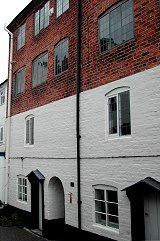|
This
picture shows a hand-loom in a weaving shop in Newtown. The workshop
is on the open upper floors while the weavers cottages are underneath.
The premises are now the Newtown Textile
Museum.
|


 rent
was high and some manufacturers paid workers in tokens
which they could only spend in his shop, where he set the prices ! (See
one of these right).
rent
was high and some manufacturers paid workers in tokens
which they could only spend in his shop, where he set the prices ! (See
one of these right).